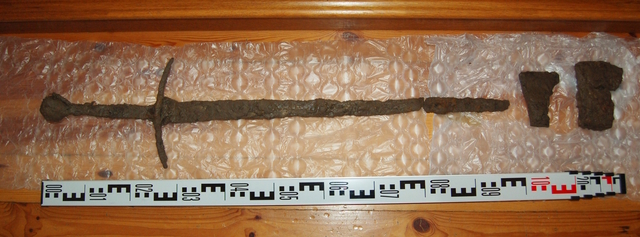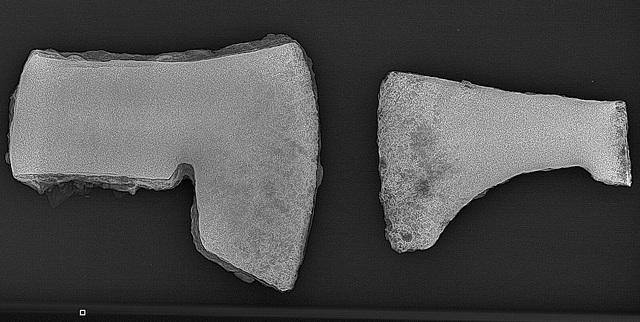In the world of archaeology, discoveries of medieval artifacts can shed valuable light on the life and warfare of times long past. A remarkable find in the Warmian-Masurian Voivodeship of Poland has just done that, with the uncovering of a rare two-handed medieval sword and two axes dating back to the 14th and 15th centuries. Made by the dedicated members of the Biskupiec Detectorists Association “Gryf,” this discovery offers not only a glimpse into the region’s rich medieval past but also highlights the enduring relationship between local communities and archaeology. These artifacts, now carefully conserved and studied, help us understand the technological advancements and the violent conflicts of the late Middle Ages.
The Discovery of the Sword and Axes
In November 2024, the Biskupiec Detectorists Association, a local group passionate about history and archaeology, stumbled upon a treasure trove of medieval weaponry. While searching for artifacts in the area around the village of Wielka Tymawa, the group unearthed a two-handed sword and two axes. This discovery was made near the Osa River, a place of great historical significance, and its proximity to an old riverbed adds a layer of intrigue to the find. The finders, following the legal procedures for archaeological discoveries in Poland, immediately reported their discovery to the Museum in Ostróda. Archaeologists were then called in to examine and excavate the site further, recovering the sword and axes.

What makes this discovery even more fascinating is the exceptional preservation of the artifacts. The sword, which measures nearly a meter in length, is in nearly complete condition, with the hilt, pommel, and guard intact. The axes, equally well-preserved, are particularly remarkable as one still retains a fragment of its wooden shaft. Such finds are incredibly rare, especially given that most medieval weapons have suffered centuries of decay. The state of preservation suggests that these items might have been submerged in the river for an extended period, perhaps due to the shifting and meandering course of the Osa River over the centuries.
Video
Watch The UnXplained: Viking Swords Inscribed with MYSTERIOUS Phrase (Season 6) to unravel the mystery behind these ancient inscriptions. A captivating exploration into Viking history!
A Closer Look at the Artifacts
The sword and axes provide insight into the design and construction of weapons used during the late medieval period. The two-handed sword, identified as a “hand-and-a-half” sword, features a long, pointed blade that was ideal for thrusting and piercing armor. These types of swords were widely used throughout Western Europe during the 14th and 15th centuries. The sword’s handle was designed to accommodate both one-handed and two-handed grips, making it versatile for combat.

The axes, while simpler in design, were also crucial weapons during the medieval period. One of the axes has a fragment of its wooden shaft still attached, which is a rare find in itself. The presence of this wooden fragment offers valuable information about the construction and materials used in medieval weaponry. Such discoveries deepen our understanding of everyday life in medieval Europe, where weapons played a vital role not only in warfare but also in defense and hunting.

Historical Context: The 14th-15th Century in Europe
The period these artifacts date back to, the 14th and 15th centuries, was a time of significant political and social change in Europe. The late Middle Ages saw the rise of powerful monarchies and the development of advanced weaponry that would shape the future of warfare. In Poland, as well as throughout Europe, the medieval period was marked by frequent conflicts and power struggles.
During this time, Poland was in the midst of its struggles with neighboring kingdoms and the remnants of the Teutonic Knights’ influence. These swords and axes would have been crucial for knights and soldiers who defended their lands and fought for control over territories. The introduction of plate armor during this period necessitated the development of stronger, more effective weapons, like the hand-and-a-half sword, which was capable of defeating armored opponents.
In the wider European context, the 14th and 15th centuries were also the time of the Hundred Years’ War, the rise of the Ottoman Empire, and the Wars of the Roses. These global conflicts spurred advancements in military technology and weaponry, influencing the development of swords and axes across Europe. The weapons found in Biskupiec may have been part of these broader trends, reflecting the regional adaptations to a rapidly changing world.

The Preservation and Study of the Artifacts
The preservation of these medieval weapons is a rare and significant achievement in archaeology. The Museum in Ostróda has taken on the task of conserving the sword and axes, using modern techniques like X-ray analysis to study the materials and construction methods. This conservation process is crucial not only for preserving the artifacts but also for gathering more information about their origins and use.
The artifacts are set to become part of the museum’s permanent collection later this year, where they will be displayed for the public. This exhibition will provide an invaluable opportunity for visitors to learn about the medieval history of the region and the importance of these objects in understanding warfare and craftsmanship in medieval Europe. Researchers continue to study the sword and axes, with plans to explore further aspects of their design and history.
The Role of the Biskupiec Detectorists Association “Gryf”
The Biskupiec Detectorists Association “Gryf” has played a pivotal role in bringing these artifacts to light. Their work highlights the contributions of metal detectorists to the field of archaeology, as they often unearth historical objects that might otherwise remain hidden. The group’s responsible and legally sanctioned efforts in the field underscore the importance of collaboration between amateur detectorists and professional archaeologists.
This isn’t the first time the group has made significant finds. In the past, they have uncovered a large collection of Carolingian silver coins in the area, further enriching our understanding of the region’s history. Their work in Biskupiec has proven invaluable in expanding the historical narrative of the Warmian-Masurian Voivodeship, shedding light on the medieval past of this often-overlooked region.
Conclusion: Shedding Light on Warmia and Masuria’s Medieval Past
The discovery of the sword and axes near Biskupiec offers a fascinating glimpse into the medieval history of Poland and the broader European context. These artifacts, with their exceptional preservation, provide valuable insights into the weapons and warfare of the late Middle Ages. The collaboration between amateur metal detectorists and professional archaeologists has proven to be a fruitful partnership, and the finds will undoubtedly contribute to the ongoing study of the region’s rich historical heritage.
As the artifacts are conserved and eventually displayed for the public, they will continue to inspire curiosity and further research into the medieval period. This discovery not only enriches the collection at the Museum in Ostróda but also helps us better understand the technological and cultural advancements that shaped Europe’s medieval past. The story of these weapons, buried for centuries and now brought into the light, offers a new chapter in the long and complex history of Warmia and Masuria.
Video
Watch Pawn Stars: Rick Has Chumlee’s Swords Appraised (Season 14) on History to see these fascinating Viking swords get evaluated. A fun and interesting moment from the show!



